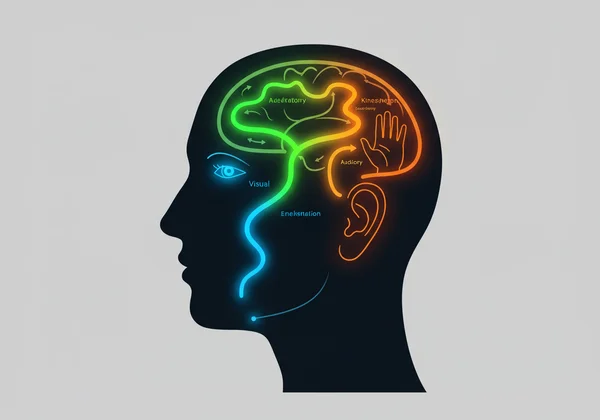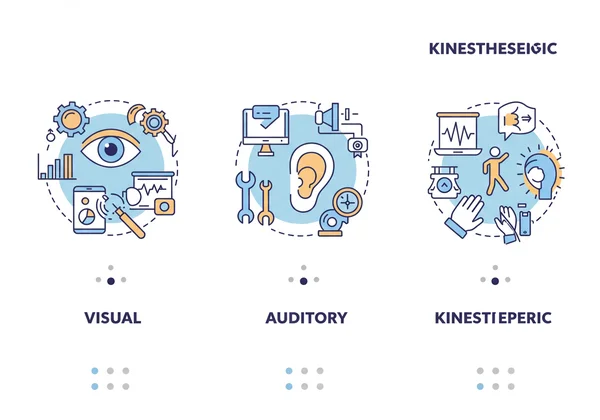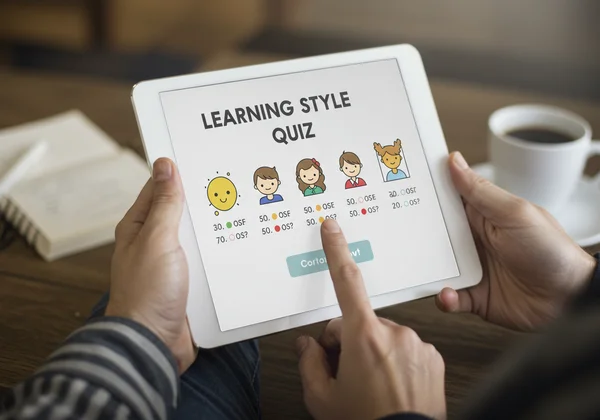Free Learning Style Quiz: What's Your VAK Type?
Do you ever feel like you're studying for hours but nothing sticks? Or perhaps you're a parent or teacher wondering why a student excels in one subject but struggles in another. The secret might not be about studying harder, but studying smarter. The key lies in understanding how you are uniquely wired to learn. This guide introduces the three primary learning styles—Visual, Auditory, and Kinesthetic (VAK). What kind of learner am I? Answering this question is the first step toward unlocking your full potential.
The journey to self-discovery starts with a single click. Our learning style quiz is designed to give you clear, immediate insights into your cognitive strengths. By understanding your natural preferences, you can transform frustration into success. Find out how you learn best by taking our free online quiz today.
What Are Learning Styles and Why Do They Matter?
At its core, a learning style refers to the unique way an individual prefers to receive, process, and retain new information. It’s not about intelligence or ability; it’s about the sensory channels your brain favors. Think of it like this: some people prefer to get their news by watching a broadcast, others by listening to a podcast, and some by reading a newspaper. None of these methods are inherently better, but one is likely more effective and enjoyable for you.

Understanding this concept is the cornerstone of effective education and personal development. When you align your study or teaching methods with a natural learning style, information flows more easily. This reduces cognitive load, boosts retention, and makes the entire learning process more engaging and less of a chore. Recognizing these differences is vital for anyone taking a learning styles quiz.
It's a Preference, Not a Label
It's crucial to view learning styles as a learning preference, not a rigid, unchangeable label. The VAK model is a tool for self-awareness, not a box to confine yourself in. Most people are a combination of all three styles, with one or two being more dominant. For example, you might be a strong Visual learner who also benefits from Kinesthetic activities.
The goal is not to exclusively use one style but to leverage your dominant preference as your primary tool while incorporating others to create a richer, more flexible learning experience. This balanced approach helps you adapt to various situations, whether in a lecture hall, a hands-on workshop, or a self-study session. True mastery comes from having a diverse toolkit of learning strategies.
The Benefits of Knowing Your Style
Discovering your dominant learning style provides a roadmap for success. It empowers you to take control of your educational journey. When you know how you learn, you can intentionally choose learning strategies that work for you, saving time and reducing academic anxiety.
For students, this means better grades and higher confidence. For educators, it offers a framework for creating inclusive classrooms that cater to diverse student needs, boosting engagement and comprehension. For parents, it provides a language to understand and support their child's homework struggles. For lifelong learners, it means mastering new professional skills more efficiently. The benefits are practical, immediate, and transformative, and it all begins when you discover your results.
The 3 Core Learning Styles: Visual, Auditory, & Kinesthetic
The VAK model is one of the most straightforward and widely recognized frameworks for understanding learning preferences. It categorizes learners based on their primary sensory receiver: eyes, ears, or body. A visual auditory kinesthetic test is designed to pinpoint which of these channels you rely on most. Let's explore each of these three core types.

Each style comes with its own set of strengths and preferred learning methods. As you read through the descriptions, you might already start to recognize your own tendencies or those of people you know.
The Visual Learner: Seeing is Believing
What is visual learning? For visual learners, information makes the most sense when it is presented in a graphic format. They have a strong ability to remember what they see and often think in pictures. If you're someone who loves colorful charts, needs to see a speaker's facial expressions, and would rather read a map than listen to directions, you likely have a strong visual preference.
Visual learners thrive when they can see information laid out before them. They often doodle while listening and find that writing things down helps them remember. To maximize their potential, visual learners should use tools like mind maps, diagrams, color-coded notes, flashcards, and educational videos. They benefit greatly from organized, visually appealing materials.
The Auditory Learner: Hearing is Understanding
As the name suggests, auditory learning happens best through sound. Auditory learners absorb information most effectively when they hear it. They excel in traditional lecture settings, enjoy group discussions, and can often remember details from conversations with ease. They might read their notes aloud or talk through a problem to solve it.
If you find yourself humming, talking to yourself, or easily getting distracted by noise, you might be an auditory learner. To enhance their study sessions, auditory learners should participate in discussions, record lectures to listen back to later, use mnemonics or rhymes to remember facts, and explain concepts to others. They learn by talking and listening, making collaboration a powerful tool.
The Kinesthetic Learner: Doing is Mastering
Kinesthetic learners, also known as tactile learners, understand concepts by doing, moving, and touching. For them, kinesthetic learning is an active process that involves physical engagement. Sitting still for long periods can be challenging for them, as their understanding is deeply connected to muscle memory and physical experience.
These individuals learn best through hands-on activities, experiments, role-playing, and building models. If you are a kinesthetic learner, you should incorporate movement into your studies. Pace while memorizing facts, use a standing desk, take frequent breaks to stretch, and apply theoretical concepts to real-world projects. The key is to transform abstract ideas into tangible actions. To see if this matches your profile, take the free test.
Find Your Profile with Our Free Learning Style Quiz
Now that you understand the three core learning styles, it's time to find out where you fit. Reading about the types can give you clues, but a well-designed assessment provides objective, data-driven feedback. Our free learning style quiz is the perfect starting point for your journey into smarter learning and teaching.

Our platform is built to make self-exploration easy and accessible for everyone. We believe that understanding yourself is the first step to achieving your goals, whether in the classroom, at home, or in your career.
Quick, Accurate, and No Sign-Up Required
We designed our quiz to be one of the most user-friendly educational tools available online. You can get your results in just a few minutes without the hassle of creating an account or providing personal information. The test is completely free and accessible to everyone.
Our assessment is based on the established JKAV™ model and has been refined using data from over 1.4 million participants. This ensures your results are not just a guess but a reliable reflection of your learning preferences, giving you a trustworthy foundation to build upon.
What Your Personalized Report Includes
Upon completing the quiz, you will instantly receive a personalized report. This free summary identifies your dominant learning style—Visual, Auditory, or Kinesthetic—and provides an initial set of actionable strategies tailored to your profile. It's a snapshot designed to give you immediate value.
For those who want to go deeper, we offer an optional AI-powered analysis. This comprehensive report turns your quiz results into a detailed success roadmap, offering advanced strategies for students, teaching tips for educators, and guidance for parents. It’s the next step in fully leveraging your unique strengths. Get your report and start today.
Ready to Unlock Your Potential?
Your learning style is your personal superpower. Understanding whether you are a Visual, Auditory, or Kinesthetic learner gives you the power to replace frustration with focus and strategy. It's the key to studying smarter, not harder.
Why wait to unlock that potential? The journey to a more effective and enjoyable learning experience is just one short quiz away.
Take our free Learning Style Quiz now and get the personalized insights you need to thrive.
Frequently Asked Questions About Learning Styles
What kind of learner am I?
The most reliable way to answer this question is by taking an objective assessment. While you can get a sense by observing your habits, a structured learning style quiz analyzes your responses to various scenarios to provide a clear profile. Our free online quiz is designed to give you a quick and accurate snapshot of whether you lean more towards being a Visual, Auditory, or Kinesthetic learner.
Which is the most effective learning style?
There is no single "best" or "most effective" learning style. The effectiveness of a style is entirely dependent on the individual. A strategy that works wonders for a Visual learner may be ineffective for a Kinesthetic learner. The most powerful approach is to first identify your dominant style and then build a flexible toolkit of strategies that also incorporates elements from the other styles. This multi-sensory approach makes you an adaptable and resilient learner.
How do you identify your learning style?
You can start by reflecting on past learning experiences. When did you feel most engaged? Was it while watching a demonstration, listening to a lecture, or participating in an activity? However, for a more structured and unbiased perspective, the best method is to use a dedicated tool. A well-designed quiz, like the VAK test here, asks targeted questions to pinpoint your natural tendencies and provides a clear summary of your personal learning profile.